On This Page
Where Do Hummingbirds Sleep?
“Hummingbirds visit my feeders every day, year-round,” says Birds & Blooms reader Kay Teseniar of Kelso, Washington. “Where do hummingbirds sleep at night, and how do they survive the chilly weather?”
Hummingbirds often find a twig that’s sheltered from the wind to rest on for the night. Also, in winter, they can enter a deep sleep-like state known as torpor. This odd behavior usually happens on cold nights, but sometimes they go into a torpid state during the day.
If you’ve ever wondered, this is how much hummingbirds weigh.
Do Hummingbirds Sleep Upside Down?

“This hummingbird (above) was hanging upside-down. Is that how they sleep?” asks Sarah Latimer of Cambridge Springs, Pennsylvania.
Although it isn’t their normal position, hummingbirds sometimes sleep hanging upside down. These tiny birds have such a rapid metabolism that they risk burning up most of their energy while they sleep. So they may go into a condition called torpor, in which their heartbeat, breathing, and other bodily functions slow way down. When they settle down to sleep, their toes close tightly around their perch. But if it’s a very smooth perch, they may slip until they are hanging head downward. It looks alarming, but usually when the bird wakes up, it can right itself with no problem. You may even seem them hanging upside down when they’re perched on a feeder.
How fast do hummingbirds fly and flap their wings?

Torpor allows hummingbirds to conserve precious energy and survive surprisingly low temperatures. Metabolism drops by as much as 95 percent. The bird isn’t any worse off when it awakens from this deep sleep. In spite of their fragile appearance, they’re tough little creatures!
So if you see a hummingbird in a strange position and a sleep-like state, don’t fret. It’s normal!
Learn more about hummingbird behavior from the experts.
Do Hummingbirds Feed at Night?
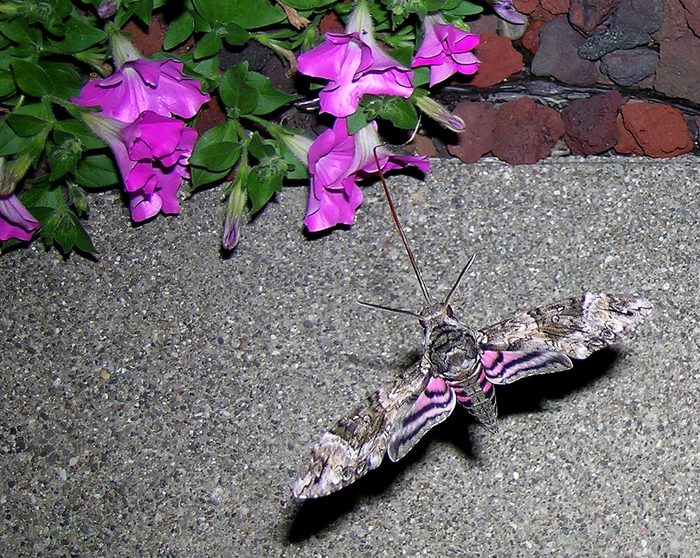
Hummingbirds feed frequently from sugar water feeders and nectar flowers during daylight hours before settling in for the night. If you think you see a hummingbird look-alike feeding on flowers after dark (such as in a moon garden), you might actually be seeing a sphinx moth, also known as a hummingbird moth. These fascinating pollinators have fooled many birdwatchers and nature lovers.
Next, learn how do hummingbirds find feeders?

If you spend a morning outside, sitting with a cup of coffee in the midst of a gorgeous garden, you’ll realize the importance of plants for pollinators. Bees, butterflies, moths and flower flies flit from one splash of color to the next. Their timeless work has kept life on our planet thriving for millennia. As we continue to urbanize, some have wondered if there’s a way to help offset the dramatic landscape changes brought on by things like buildings, concrete and asphalt. Researchers say yes, to some degree, and the key is in your backyard. The best thing you can do to help pollinators is plant a pollinator garden!
These 11 succulents will bring pollinators to your yard.
Why You Should Plant a Pollinator Garden
Scott Schell, a University of Wyoming extension entomologist, says having flower-filled private yards, in addition to natural areas and public gardens with fragrant pollinator favorites, is important. These gardens will provide corridors for these insects to travel, explore and get the resources they need. New research is showing that while city garden plots cannot replace wild lands, they certainly can help.
A 2019 study published in the Nature Ecology and Evolution journal outlined years’ worth of research in the U.K., analyzing the importance of natural green spaces in cities. Researchers discovered that the biodiversity of pollinators is directly connected to both the amount and the diversity of plants in particular areas.
That knowledge is critical. A wide range of tiny creatures—from the showy monarch butterfly to the humble flower fly—is responsible for supporting 85% of the world’s flowering plants and helping to keep more than two-thirds of the world’s crop species going. In addition, fruits and seeds from pollinated plants are a diet staple for 25% of birds and many mammals.
While catering to pollinators seems intuitive, a few tips and tricks should make your yard and gardens even more fruitful for all of your flying friends.
Make sure you plant these flowers that attract bees.
Plan Your Pollinator Garden

“Before heading out to buy plants and seeds, take a minute to just simply sit and observe,” says Jennifer Thompson, the University of Wyoming’s small acreage outreach coordinator. “Look around your yard, your friends’ yards, your local parks, local nurseries and flowering plants near businesses,” she says. Ask yourself: “Which plants are being visited by bees, butterflies, other insects and hummingbirds?”
Make a note of which plants seem the most interesting for pollinators and focus on those. If you don’t have time to watch and categorize, she suggests visiting your local extension office or its website for recommendations of plants that lend a hand to pollinators.
Check out our favorite blooming bushes that attract butterflies.
Grow Plants for All Seasons
“Consider flowers that bloom from early spring until late fall to cater to the largest number of pollinators,” Jennifer says. “Many native bees, for instance, have very short adult lives. Different species will emerge and visit your yard at different times during the season,” she says. “Have something blooming when they come out.”
Psst—try these long-blooming flowers to attract butterflies and hummingbirds.
Mixing flowers with different bloom times also helps your garden stay vibrant continuously throughout the seasons. One recommendation for early spring pollinators is a sand cherry shrub.
Want to attract pollinators, but don’t have much space? Try a fireside ninebark shrub.
Replace Grass with Native Plants
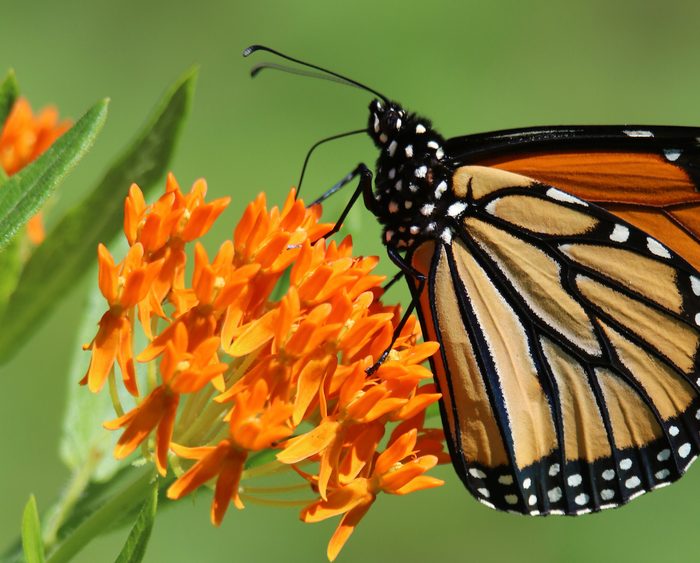
Many of us like order in our yards and gardens. But senior lecturer Katherine Baldock, a U.K. pollinator researcher, recommends letting your yard be just a touch messy. Consider mowing less frequently so the clover or dandelions have a chance to bloom. If you have an area that can go wild with native plants, let it. Think about reaching out to your local municipality to inquire about planting more flowers in public places or even converting portions of green parkland into spaces for natives.
Get started with the top 10 easy-to-grow native plants.
Vegetable Gardens for Pollinators

Add a few more vegetables as you’re planning a garden. Not only will you appreciate your forethought during the later harvest, but insects will also appreciate the variety. Katherine says crops benefit from pollination. And pollinators, in turn, benefit from the large amounts of pollen and nectar. If you don’t have room, plant vegetables in pots or consider joining a community garden.
Did you know—tomatoes make great sunflower companion plants
More Tips to Help Pollinators
- Leave small rocks on patches of dirt, Scott suggests, for pollinators that nest on the ground.
- “Move plant stems and other yard waste into an out-of-sight pile if you can’t take the mess,” Jennifer says. Pollinators will emerge in spring.
- Resist the urge to use a weed barrier on your landscape.
- Skip cleaning up any dead stems and twigs on your yard at the end of the growing season. Scott says, “Some species of pollinators use that habitat for their overwintering generation.”
Learn how to make a DIY butterfly puddler.
Readers Share Their Top Pollinator Garden Tips
- “I plant some prairie natives and host plants for caterpillars, including milkweed for monarchs and dill and fennel for black swallowtails,” Eva Bellinger says
- “It was my goal to create a backyard bird, bee and butterfly haven. To achieve this, I planted bee balm, coneflowers, beautyberry, phlox, butterfly weed and more. I also have potted hibiscus and lantana,” Mary Willmuth says.
- “We have a 7-foot Joe Pye weed that is a magnet for bees and butterflies,” Cheryl Rogan says.
- “My entire front yard, about a half acre, is full of wildflowers,” Debbie Foote says.
After you’re done planning and planting your pollinator garden, check out green gifts to help pollinators.

May is one of the best months of the year! The sun is out, flowers are blooming and summer is just around the corner. Celebrate all the wonderful things May has to offer with lily of the valley. This fantastically fragrant flower is also the official birthday flower for those born in the month of May.
Here’s everything you need to know about the May birth flower. And if your loved ones have May birthdays, we found the best May floral-inspired gifts to help them celebrate. (Don’t miss our January, February, March, April, June, July, August, September, October, November and December birth flower gift guides too!)
What is May’s Birth Flower?
May’s birth flower is the lily of the valley. The delicate blossoms of the May birth flower resemble tiny white bells hanging from green stems. Lily of the valley flowers are small, but mighty. They have one of the loveliest scents you can imagine—making it a popular choice for fresh cut bouquets, perfumes and more. Their fragrant scent also attracts pollinators to your garden, like bumblebees and butterflies.
These perennials also provide excellent ground cover in a garden’s shady spots. But before you decide to plant them, know that they require a control border to keep them from spreading too aggressively.
What Are the Meanings of May’s Birth Flower?
With its sweet scent, it comes as no surprise that one of the most popular meanings of May’s birth flower is sweetness. Lily of the valley also symbolizes hope, purity and humility. The May birth month flower has a long history and many different meanings across cultures. In Greek mythology, Apollo grew lily of the valley in the woods to protect the feet of his muses. In German mythology, lily of the valley is associated with Ostara, the virgin goddess of spring. Lily of the valley is also mentioned more than a dozen times in the Christian Bible.
Do hummingbird sightings have special meaning?
More May Birth Flowers

May has another birth flower—the hawthorn, which blooms with flowers in the spring and produces small, edible fruits in the fall that last nearly all winter. Hawthorn shrubs provide food and a protective area for birds to nest. For those with May birthdays, the hawthorn is thought to represent hope and happiness. These backyard birds will enjoy snacking on hawthorn berries.
Now that you know more about May’s birth flowers, we’ve got the perfect lily of the valley-inspired gifts for everyone on your May birthday list—from jewelry and notepads to art prints and everything in between.
May Birth Flower Gift Guide
Lily of the Valley Shower Steamers

No bathtub, no problem. Lily of the valley scented shower steamers are designed to release floral fragrance into the shower, scenting the entire bathroom with May’s favorite flower. This set of four steamers includes birthday-inspired packaging handmade in Austin, Texas.
Enamel Keychain

May birthdays are celebrated all year long and every time they leave the house with this lily of the valley enamel keychain. Make this gift extra special by adding a brass tag engraved the name or initials of your loved one.
Lily of the Valley Birth Flower Candle

Sit back, relax and enjoy the sweet scent of this May birth flower candle. Available in two sizes (a reusable rocks glass or a large tin), this hand-poured candle also includes a reminder of all the beautiful things the May birth flower represents.
Lily of the Valley Linen Napkins

A set of four linen napkins embroidered with different lily of the valley motifs is an elegant gift to pair with a bottle of wine or bouquet of flowers. The set can also be used for coasters.
Birth Month Flower Glass

Make a toast to May birthdays with this memorable birth month flower glass. To make them, beautiful lily of the valley blooms were carefully pressed and turned into digital prints to adorn the sides of curved glass tumblers. Birthday cheers!
Lily of the Valley Art Print

What’s not to like about this gorgeous giclee print of an original watercolor painting? Available in three sizes, this piece of art looks stunning wherever you hang it. Note that it doesn’t arrive framed.
Hawthorn Seeds

Give the gift of Hawthorn seeds to the May born gardener in your life. This May birth flower is able to grow in a variety of conditions and the results are wonderful: gorgeous flowers in the spring and small, edible fruits that attract birds throughout the winter. A packet of seeds is the perfect addition to a bird greeting card.
Lily of the Valley Notepad

This pretty notepad is perfect for writing weekly to-do tasks, shopping lists or a handwritten letter. Each notepad comes with 50 sheets of paper printed with the artists’ original, hand-painted lily of the valley illustration.
Lily of the Valley Perfume

This roll-on perfume lets you enjoy the scent of May’s birth flower—without the flowers! Handcrafted in small batches, this perfume smells just like fresh lily of the valley. What a delight!
May Birth Flower Necklaces

Celebrate your loved one’s special day with this thoughtful heart-shaped necklace featuring a hawthorn flower. Customize in gold or silver, and the text of your choice on the back. The same necklace is available with lily of the valley flowers instead.
Lily of the Valley Plants

Add elegance to the garden with these bare root Lily of the Valley plants. This classic blooms with fragrant flowers in the spring, which last for several weeks. Each order includes 20 bulbs for the birthday boy or girl. Check out the best websites for buying flower bulbs online.
Lily of the Valley Enamel Pin

Known as a symbol of good luck and happiness, this lily of the valley pin is a thoughtful gift. The polished, gold-plated hard enamel pin is a lovely reminder of how much you care.
May Birthday Mug

This personalized birthday mug features an illustration of lilies of the valley, along with the name and date of your choice. The design is featured on both sides, so it can be enjoyed any way you look at it!
For every bed of colorful tulips and thriving vine of ripe tomatoes, a little history and wisdom are buried in the soil. From one generation to the next, families inherit and share the joys of digging in the dirt and seeing what sprouts. In honor of Mother’s Day, Birds & Blooms readers recount what they learned and loved about being shoulder to shoulder with Mom or Grandma in the backyard.
Check out 25 secret garden tips we learned from Grandma.

Mom’s Purple Flowers
My sister planted a row of these beautiful purple irises a couple of years ago in memory of our mom. She loved purple flowers. Every year when they bloom, we think of her and smile.
Gail DeAngelo
Schenectady, New York
Check out 15 adorable photos of bird mothers with babies.

24 Years of Blooms
These tulips were my mother’s favorite. When she downsized and moved in 1983, she took the flower bulbs with her. And when she passed away, I planted them in my garden. A few years later a single striped bloom emerged. Tulip plants are typically not long-lived, but this bloom has returned for 24 years. Every spring it reminds me of my mother.
Gabriela Surerus
Roseneath, Ontario
Learn about the the life of a female hummingbird.

Pink Lily Memories
This pink rain lily is very old and belonged to my grandmother. She gave it to my mom, who handed it down to me. They have both passed, so I treasure the plant very much. I am always thrilled to see it in bloom every year!
Elaine Chapman
Centreville, Virginia
Check out Mother’s Day garden gifts your mom will adore.
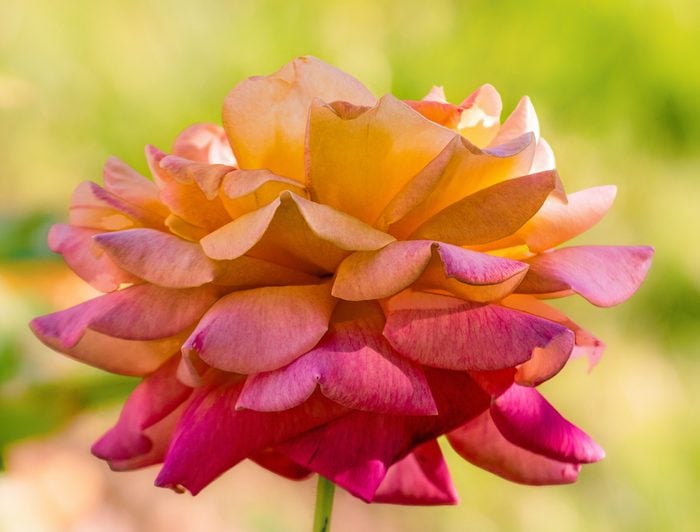
A Special Rose
I love going to my mom’s to photograph this Enchanted Peace rose when it is in bloom. Every time I see it, I think of her and how special she is to me! The petals create delicate layers and the aroma is so sweet, just like my mom.
Lisa Watkins
Mechanicsville, Virginia
We found 15 pretty rose gifts for rose lovers.

Abundant Harvest
Whether in the kitchen or the garden, my mom and I made quite a team. She was always on board with my harebrained ideas. I started keeping a journal of my gardening adventures in 2002, and I carefully recorded everything from temperature variations to pest problems. My journal entries also tell of hard-fought battles, with my mom and me joining forces against weather and wayward wildlife. One memorable August entry said, “We found out what was chewing our cabbage and tomatoes. A groundhog! Mom was picking tomatoes and it was hiding in the tomato plant. Scared her to death!” For a while after that incident, we carefully searched each plant for camouflaged critters before tending the garden.
Although the pages of my journal are mostly filled with dates, facts and numbers, my memory is filled with something far sweeter: early-morning conversations that Mom and I enjoyed during planting and harvesting, the air around us heavy with lingering dew; and the times we sat side by side in the heat of the day, sipping ice water under the cool shade of the fruit trees.
As I look back, I realize that the one-on-one time we shared in the garden was not just about growing food. It was about growing the appreciation and love we had for each other. We were sowing and reaping the sweetest and most abundant harvest—a harvest that never ends.
DeAnne Beyer
Lancaster, Ohio
Don’t miss these bird-themed gifts for Mother’s Day.
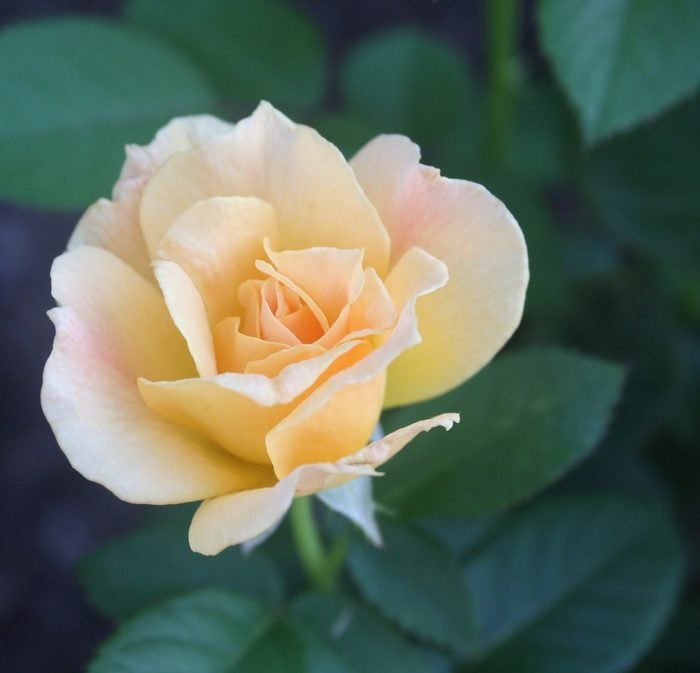
Rosy Reminiscing
Nana’s favorite rose was the yellow-pink Peace rose. Her sun-drenched English garden was bursting with these and other perennials, such as hot pink ruffled peonies. Every Memorial Day, she gathered her peonies and took them to the family plot. Nana lived in Yakima Valley, Washington, which is known for orchards, so apple and pear trees were perfectly at home in her yard. She espaliered the trees, carefully pruning and training them to grow flat against a wall. She also had beds of red petunias around her swimming pool. Every September, we said goodbye to the swim season by plucking the heads off the petunias and throwing them into the pool to float. To a 6-year-old, it was magical.
Stacy Heintz
Cle Elum, Washington
Plant these fragrant roses to perfume your garden.
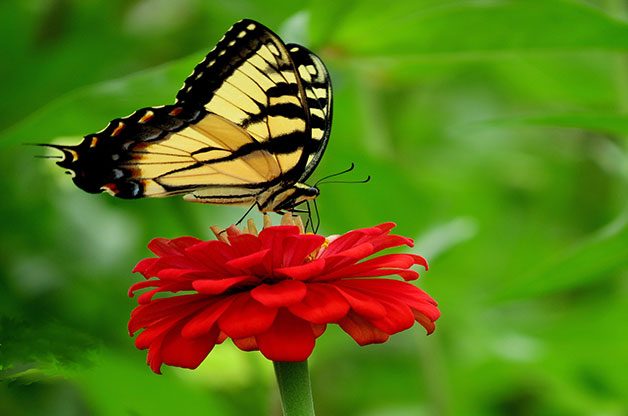
Grandma’s Zinnias
As a child, I loved walking in my grandmother’s garden. She always grew zinnias; my garden would not be complete without zinnias. One lovely summer day, as I was taking a walk in my garden, I spotted this tiger swallowtail butterfly touching down. Butterflies love zinnias as much as I do, and this particular species is one of my very favorites. When I look at this photo, I remember my grandmother and wonder if perhaps her spirit was visiting my garden that day.
Mary Lou Jubin
Norton, Ohio
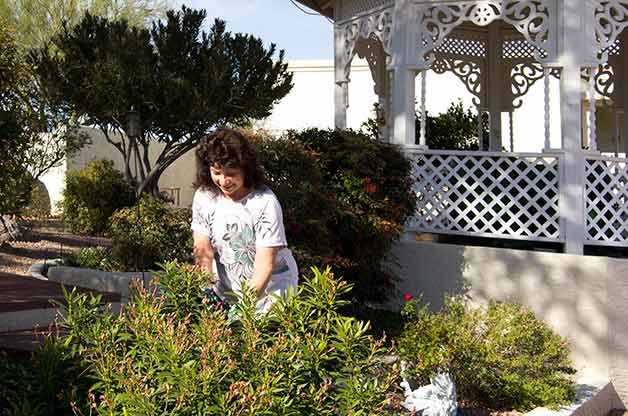
Never Give Up
I grew up in San Jose, California, where just about anything we planted grew well, but when I was 12 years old, my family moved to Tucson, Arizona. Mom left behind her sunflowers, vegetable garden, peach and fig trees, ice plants and lots of healthy grass. Tucson was another story. She watched one plant after another die. I’ve never seen my mother so angry and frustrated with gardening. Mom never gave up, though. She was determined to grow a garden in the desert.
As she dug holes for plants, she would hit caliche (soil particles cemented together by lime). A lesser gardener may have been tempted to give up and just stick the plant in the hole, accepting that the roots would be shallow, but not Mom. Instead, she went out and bought herself a caliche pole, which is a heavy metal rod with a sharp point on the end. It was either that or a jackhammer. Over and over again, she slammed that pole against the hard soil until the hole was deep enough and there was enough drainage for her to put the plant in its new home.
My mom has always been a hard worker. She wanted my brothers and me to learn how to be hard workers as well, and I remember us kids gathering around several holes and taking turns with the pole. We learned that gardening wasn’t always a pleasure. (Thirty-five years later, she still has that pole; I frequently ask to borrow it for my own yard!)
She taught us all so much, including the importance of water conservation, planting annuals in cooler months, and which drought-tolerant plants flowered best. When it was my turn, I knew exactly what to do. As a result, I have my own beautiful desert garden that’s bird-, bloom- and butterfly-friendly. Thanks, Mom!
Deborah Lockett
Tucson, Arizona
Plant these drought resistant trees for birds and wildlife.
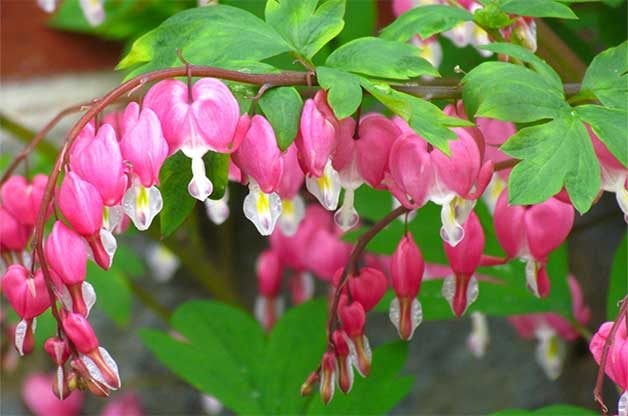
Mom’s Legacy
I was raised on a dairy farm, and like the rest of our neighbors, my mom had the usual vegetable garden. Unlike the neighbors, she also had a large flower garden filled with peonies, bleeding hearts and dianthuses. I didn’t realize the legacy she left me until I started flower gardening years later. I think of her when my own peonies and dianthuses bloom.
Ken Wellnitz
Davenport, Iowa
Check out photos of beautiful flowers to inspire your dream garden.
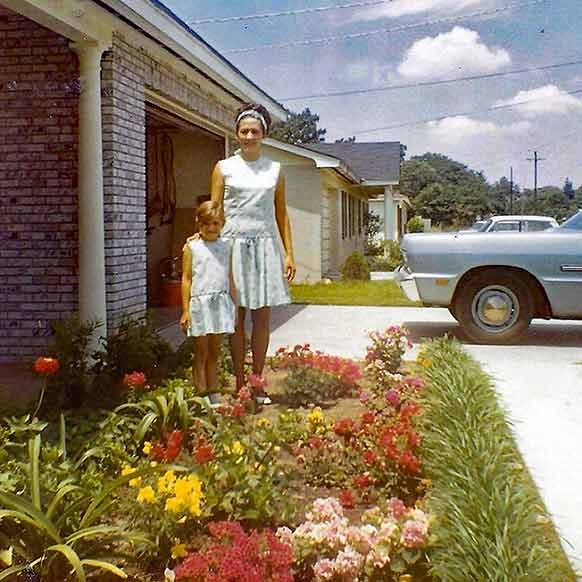
Grow Your Own Food
Mom had a huge vegetable garden in the back corner of our yard. We planted, watered and weeded, but what I most looked forward to was the harvest. There was invariably enough for a quick taste test while we gathered the bounty. Mom would always tell me to wash them off first, but I was too excited and would pop the fresh veggies right into my mouth!
Doreen Damm
New Port Richey, Florida
We found fun harvest-themed gifts for vegetable gardeners.

Flower Tips and Tricks
My grandmother was quite the gardener, and from a very young age I loved working beside her in her lush garden in Hampton, Virginia. Her living and dining rooms always smelled sweet because she picked almost every bloom right from her garden and created beautiful flower arrangements.
She swore by dehydrated cow manure for fertilizer and had hundreds of jonquils, huge hydrangea bushes (alternating pink one year and blue the next), irises, Shasta daisies, annual zinnias and more. Every time I work in my own garden, I think of her.
Beth Jeffress
Midlothian, Virginia

Gardening With Grandma Minnie
Grandma Minnie loved pansies. After we moved her from her home and big yard into a small apartment, my mom would take her shopping each spring to pick out six-packs of pansies. Then Mom would plant the most beautiful window boxes and planters for Grandma’s porch. My grandma would patiently deadhead to encourage more blooms, and I still use that good gardening lesson today!
Jessica Allen
Palmyra, Pennsylvania
How Do Hummingbirds Find Feeders?
Move over, elephants! Hummingbirds have excellent memories. If you think the same hummingbirds come back to your feeders every year, you might be right! They even remember which flowers they’ve already sipped from. Banding research shows they are likely to return to the area where they hatched. For instance, we know ruby-throated hummingbirds follow the same migration routes every year. They also arrive at and leave from stopover points on almost the same date each year, within a few days. Birding experts Kenn and Kimberly Kaufman answer the question: How do hummingbirds find feeders?
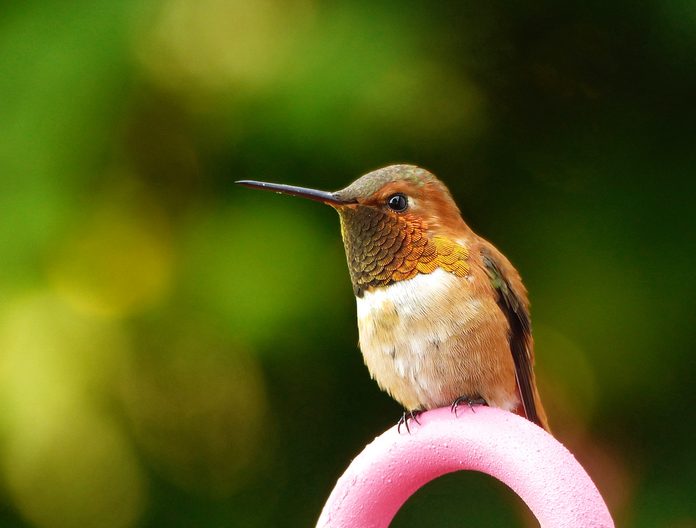
“We were finally successful in attracting ruby-throated hummingbirds with feeders. Now that we’ve attracted them, will the same group and their offspring return to our backyard next year?” asks Dennis Woods of Greensville, Ontario.
Kenn and Kimberly: Now that you’ve had success in attracting the ruby-throats, there’s a good chance they’ll come back every year. Young hummingbirds usually return to the general area where they were hatched. In addition, hummingbirds have strong spatial memory, and they may return to the same spots where they’ve found food in the past, even after migrating thousands of miles. If you have feeders and flowers ready at the right season, you can expect to have plenty of hummingbirds.”
Red colored flowers and feeders may help catch their attention, but skip adding red dye or food coloring to sugar water as it could be harmful for the birds. (And never add these ingredients to sugar water, either!)
We asked the experts: how long do hummingbirds live?
Hummingbirds Remember Food Sources

Readers often write in to Birds & Blooms to report seeing the same hummingbirds at their feeders. “These ruby-throats (above) come back to my front yard every year, and I love to sit and watch them,” says Clatis Tew of Butler, Alabama.
Great memory has also been also observed in other types of hummingbirds, including rufous and Allen’s.
“If an Allen’s hummingbird really likes your yard, it will come back year after year. They are very site-specific,” says Barbara Monahan, whose property in Santa Cruz, California, was a banding site for 3,000 hummingbirds for the nonprofit Hummingbird Monitoring Network.
Next: Did you know hummingbirds can see even MORE colors than humans, according to researchers. Plus, was the Lucifer hummingbird really named after the devil?
As gardeners, we’re constantly faced with challenges: plants that won’t bloom, flowers that die from a late frost, droughts that wipe out entire beds. Gardening definitely has its fair share of difficulties, so every once in a while it’s nice to have plants that require little maintenance. Even better-grow resilient flowers and plants that you can’t kill!
Sure, spraying these all-stars with weed killer would probably lead to their demise. But for the most part, these are hardy, maintenance-free picks that work well in any North American backyard. So are you ready to trick everyone into thinking you have a green thumb? Get planting with these top picks for plants you can’t kill.
Also check out the top 10 hard to kill houseplants.
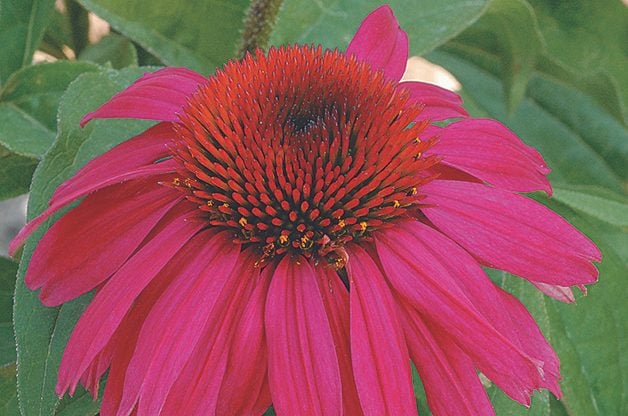
Coneflower
Echinacea, Zones 3 to 9
Coneflowers have become a garden staple for their easygoing nature. Growing 2 to 5 feet high and 2 feet wide, these resilient flowers are the perfect companion plant in just about any garden. They require well-drained soil but will thrive in full sun as well as partial shade. Known for attracting birds, bees and butterflies, coneflowers also make lovely cut blooms.
Why we love it: The coneflower is the low-maintenance star of nature-friendly gardens. It comes in many colors, and it’s easy to find one you and the birds will love.
Discover more purple flowers to grow in your garden.
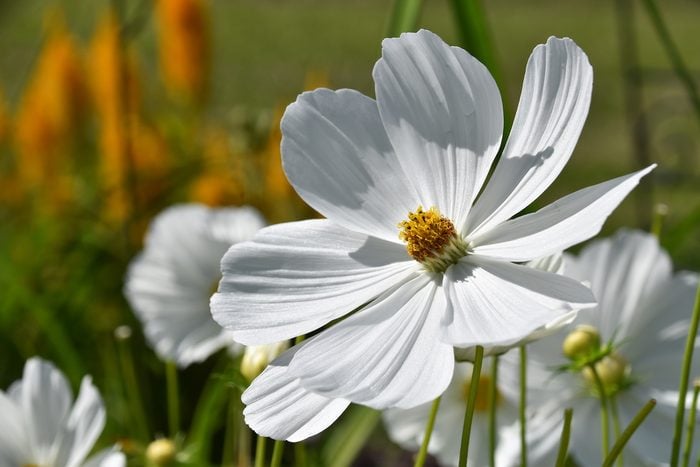
Cosmos
Cosmos bipinnatus, annual
If big, beautiful resilient flowers are one of your top requirements, cosmos is perfect for you. Though it’s an annual, it often reseeds on its own. Blooming summer to frost and growing up to 6 feet high, this backyard favorite deserves a regular spot in your sunny garden. Cosmos flowers are beloved by bees and butterflies, too.
Why we love it: Cosmos is easy to grow from seed. Grab a seed packet for a few bucks, and you’ll have a gorgeous show in a single season.
Treat yourself with chocolate cosmos flowers.

Daylily
Hemerocallis, Zones 3 to 10
An excellent choice for a classic garden, daylilies can tolerate flooding, drought and salt and are often used for erosion control on steep hillsides. The pretty blooms come in every shade except blue and pure white; their distinctive trumpets may be triangular, circular, double, spidery or star-shaped. Daylilies grow 10 inches to 4 feet high and 1-1/2 to 4 feet wide and do best in full sun to partial shade.
Why we love it: Some cultivars attract hummingbirds and butterflies. A plant that is best divided every three to five years, the daylily is perfect to share with friends.
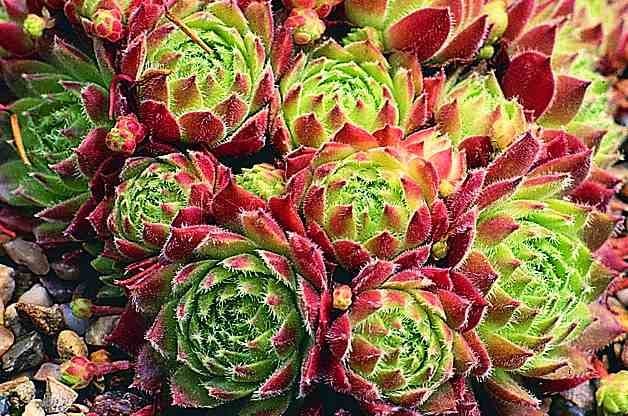
Hens and Chicks
Sempervivum tectorum, Zones 3 to 8
The only way to kill this succulent is by being too kind with overwatering. This perennial is perfect for rock gardens. It grows 3 to 6 inches tall and up to 20 inches wide and blooms in summer. For best results, plant in well-drained soil that gets full sun to light shade.
Why we love it: This low grower also works wonders in containers. Since it doesn’t have a deep root system, you can plant it somewhere fun. Try growing it in an old birdbath or shoe.

Yarrow
Achillea, Zones 3 to 9
These easy-care, long-lasting flowers come into their own once summer is on its way. They grow 6 inches to 4 feet tall and 18 to 24 inches wide, in yellow, white, red and pink. Well-suited to most growing conditions, yarrows provide a long season of bloom. They’re a good cutting flower, too. Avoid seedy varieties that may require a bit of weeding to keep contained.
Why we love it: This plant is drought- and heat-tolerant and can survive on benign neglect.
Check out the top 10 easy-to-grow native plants.
Hosta
Hosta, Zones 3 to 8
Easy-to-grow hosta is a must for shade gardens. The beautiful foliage comes in a wealth of colors, textures, sizes and shapes, growing 4 inches to 3 feet high and 6 inches to 6 feet wide. In summer, hosta blooms in purple, white or lavender. Divide in spring or late summer to early fall. Hostas like moist ground, but be careful not to overwater. Do hostas attract hummingbirds?
Why we love it: The ultimate low-care shade plant, hosta comes in endless varieties and colors. It also can be easily divided—perfect for the budget-minded.
Also try the top 10 shade tolerant coral bells varieties.

Sedum
Sedum, Zones 3 to 10
Take a close look and you’ll see this plant’s star-shaped blooms, similar to a pentas. With yellow, orange, red, pink or white resilient flowers, it grows from 2 inches up to 2 feet high and wide. You can grow some sedum species as ground cover, while others make good border plants.
Why we love it: Hello, butterflies! If you want pollinators in your yard, sedum is a slam dunk.
Find more late-blooming fall flowers that attract butterflies.

Zinnia
Zinnia, annual
With new heat-, drought- and disease-resistant plants on the market, there’s never been a better time to grow zinnias. This annual grows up to 3 feet high, with blooms that last until the first frost. For the newest varieties from seed, check your local nursery or favorite garden catalog. If you don’t find what you’re looking for, order online.
Why we love it: You’ll save tons of money growing these from seed. Start seeds indoors, or sow outdoors about 1/4 inch deep after the threat of frost has passed.
We found more butterfly flowers that are easy to grow from seed.

Petunia
Petunia x hybrida, annual
Petunias have been around for decades, but the newer varieties have advanced in leaps and bounds. Days of deadheading and disease-prone plants are long gone. Nowadays, these beauties flourish in both full sun and partial shade without a lot of extra work. And you can find these resilient flowers in almost every color imaginable.
Why we love it: Even if you forget to water for a few days—it happens to everyone—petunias keep going.
Check out the top 10 best flowers for growing in pots.
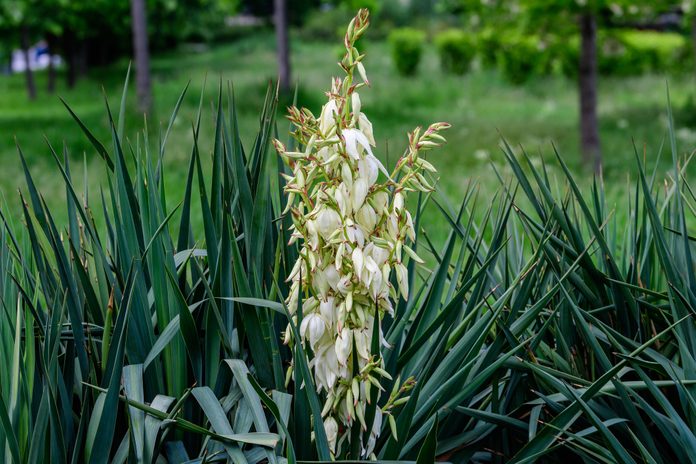
Yucca
Yucca filamentosa, Zones 4 to 11
There’s a good reason so many Southern gardeners use yucca as a backyard centerpiece. It’s about as drought-tolerant as they come-and on top of that, it boasts beautiful white flowers amid its spiky leaves.
Why we love it: Both flowers and foliage come with this beauty. For a unique variety, look for the variegata cultivar. Its blue-green leaves with white edges are stunning.
Once you start growing coral bells, you won’t be able to stop. Yet they are among the most underused plants in the garden. These charmers (also known as heucheras) are shade tolerant, their foliage is striking and their blooms attract hummingbirds. Trust me: You’re going to wonder how you ever got along without these powerhouse plants. There are dozens of varieties of coral bells out there, so think of this list as a starting point. Once you figure out what you’re drawn to—orange leaves, red blooms, variegated foliage—start looking around for more. The sheer number of options will blow you away, and then you can start spreading the news to others!
Check out 18 fabulous foliage plants for garden pizzazz.
On This Page
Blackberry Ice
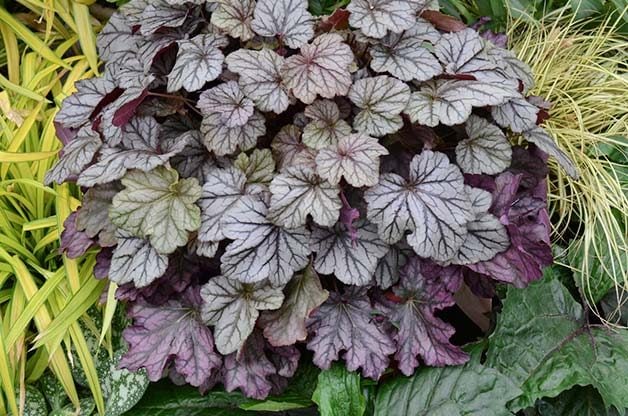
Zones 4-9
This reddish-purple variety is part of the popular heat-tolerant Dolce series. Take a close look at the leaves, and you’ll see black veining. While some heucheras bloom in spring, this one shows off pretty white blossoms in midsummer.
More dark foliage: Chocolate Ruffles, Lava Lamp
Check out the top 10 dark colored flowers that are almost black.
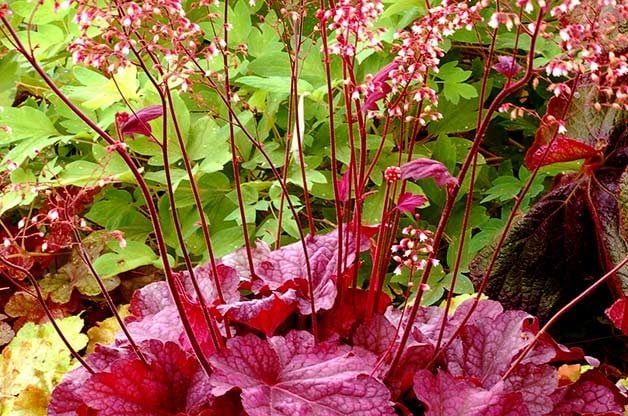
Berry Smoothie
Zones 4-8
The foliage starts off rose-pink but darkens to a purplish shade as the summer goes on. The light pink blooms start in late spring; if you keep deadheading them, you should get flowers all summer long. Grow in partial shade and keep the plants well watered, especially when you’re trying to get them established.
More burgundy picks: Plum Pudding, Bella Notte
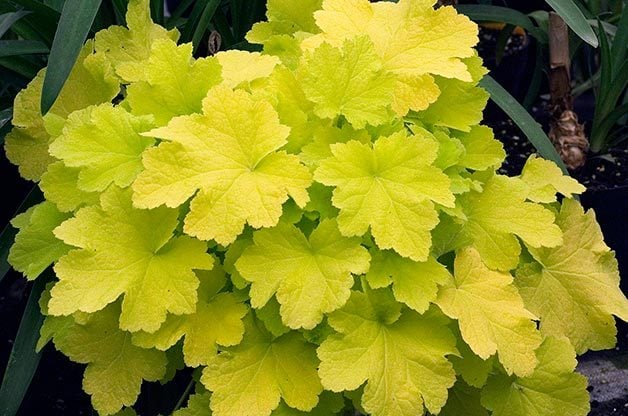
Citronelle
Zones 4-8
If heat tolerance is a requirement for your plants, this is one of the best coral bells for you. The lime-green foliage alone will turn heads. Grow this one in partial shade for best results.
More lime-green picks: Electric Lime, Pistache, Lime Marmalade
We found 10 gorgeous green flowers for your garden.
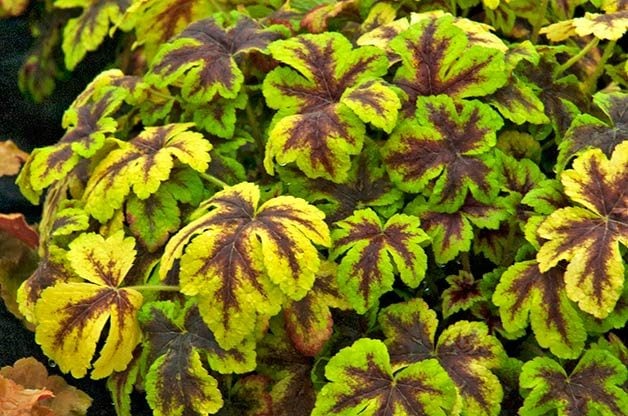
Gold Zebra
Zones 4-9
This whimsically named heuchera gives you two dramatic foliage colors for the price of one: Its bright yellow leaves, scalloped at the edges, boast dark red centers. Gold Zebra performed like a champ during testing in hot, humid Oklahoma summers. Be sure to plant it in at least partial shade.
More variegated picks: Solar Eclipse, Ring of Fire
Grow croton plants for year-round fall foliage.
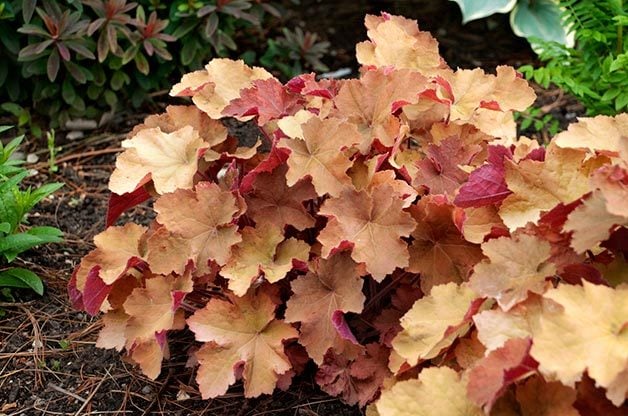
Caramel
Zones 4-8
Here’s another one that can really withstand the summer heat! It can stand up to sunny locations, but it will do best if you can offer it some shady relief and sufficient moisture, especially in the afternoon. Around midsummer, look for soft pink blooms shooting up from the rich caramel foliage.
More caramel-colored picks: Christa, Buttered Rum
Check out the top golden plants to make your garden glow.
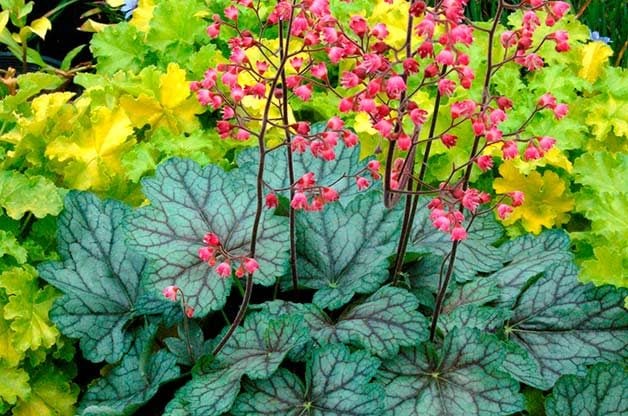
Peppermint Spice
Zones 4-9
Many gardeners consider Peppermint Spice the perfect coral bell cultivar, with its gorgeous rose-pink blossoms—what many think of when they picture heucheras—and silvery-green foliage. Expect flowers to open in summer and plants to grow 8-10 inches tall.
More red blooms: Ruby Bells, Berry Timeless
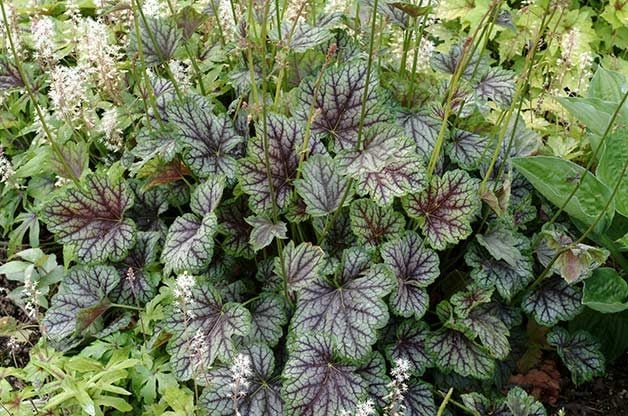
Green Spice
Zones 4-9
Here’s another heuchera with really cool veined foliage, plus flashes of silver. In colder weather, the veins have a purple cast. The little white flowers will appear in late spring or early summer.
More top leaf picks: Cinnamon Curls, Brass Lantern
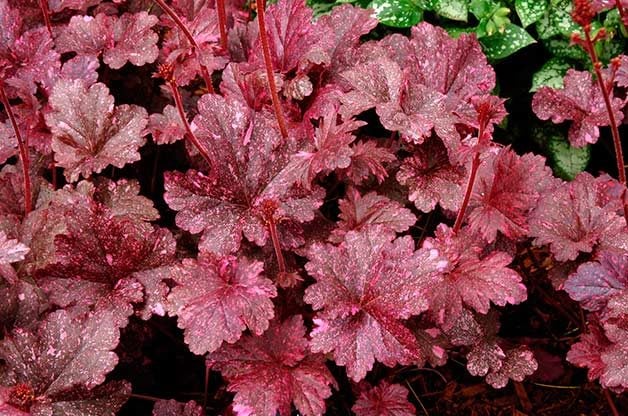
Midnight Rose
Zones 4-9
Love dramatic foliage? You can’t go wrong with the black leaves of this one. They start off very dark, with tiny specks of pink that get bigger and paler as the season goes on. At just 10 inches high, this cultivar has a low, mounding growth habit.
More black foliage: Obsidian, Brazen Raisin
For more vibrant foliage, check out the top 10 colorful coleus varieties.
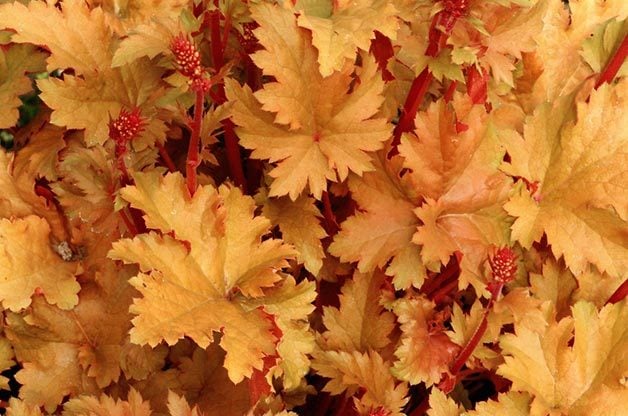
Amber Waves
Zones 3-8
This one’s a prizewinner, having grabbed a “best new plant” award in 2001, and it’s not hard to see why. You get lovely copper foliage, ruffled leaves, pink buds and cream-colored blooms.
More award winners: Stormy Seas, Melting Fire, Quilter’s Joy
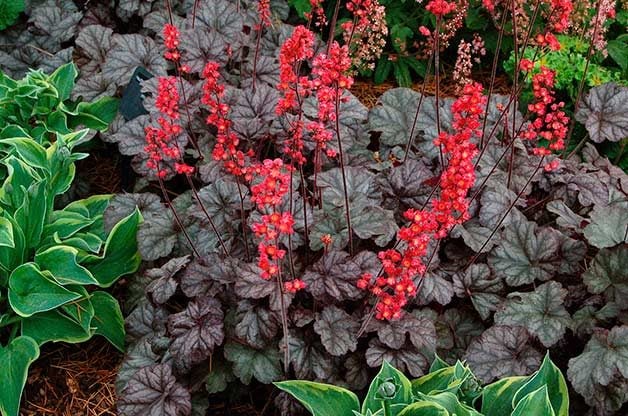
Hollywood
Zones 4-9
Most people grow heuchera for the foliage, but Hollywood is proof that this plant deserves applause for its flowers, too. Hummingbirds love coral bells, and the bright red blooms of this one will have them flocking to your yard. The foliage is nice, too: dark with a touch of silver and scalloped edges.
More delectable blooms: Heucherella Dayglow Pink, Heucherella Honey Rose
Why Trust Us
For nearly 30 years, Birds & Blooms, a Trusted Media Brand, has been inspiring readers to have a lifelong love of birding, gardening and nature. We are the #1 bird and garden magazine in North America and a trusted online resource for over 15 million outdoor enthusiasts annually. Our library of thousands of informative articles and how-tos has been written by trusted journalists and fact-checked by bird and garden experts for accuracy. In addition to our staff of experienced gardeners and bird-watchers, we hire individuals who have years of education and hands-on experience with birding, bird feeding, gardening, butterflies, bugs and more. Learn more about Birds & Blooms, our field editor program, and our submission guidelines.
The arrival of April means brighter and warmer days, with the bonus of spring’s flowers just starting to bloom. One of the most cheerful and common flowers is the April birth flower—it’s the daisy. Here’s everything you need to know about the April birth flower. And to help your friends or family celebrate their April birthdays, we found the best April floral-inspired daisy gifts to help them celebrate.
April’s birth flower is the daisy. While most people think of traditional daisies as small flowers with white petals surrounding a bright yellow center, gardeners know there are more than 20,000 varieties of daisies! in fact, 38 different flower species that share the common name “daisy.” Some of the most well-known are Gerbera daisies, Shasta daisies, gloriosa daisies, marguerite daisies and purple coneflower daisies.
These happy little flowers get their name from the Old English phrase, “daes eage,” meaning “day’s eye.” This phrase refers to the light-sensitive nature of the daisy. The flower opens its petals when the sun begins to shine in the morning and closes its petals at night.
Check out these delightful flower arrangements we’re ordering for Easter.
Don’t miss our January, February, March, May, June, July, August, September, October, November and December birth flower gift guides for all the birthdays in your life!
What Are the Meanings of the April Birth Flower?
Blooming at the start of spring, daisies symbolize new beginnings, purity, hope and happiness. The daisy has rich mythological history too. In Norse mythology, daisies were associated with Freya—the goddess of fertility and guardian of new mothers. In Roman mythology, a nymph named Belides transformed herself into a daisy to hide from unwanted attention. And in Celtic mythology, daisies were sprinkled over the earth to cheer up grieving parents. Check out the unique meanings behind the rest of the birth month flowers, too.
More April Birth Flowers

While daisies are most commonly thought to be the April birth flower, they aren’t the only one. Sweet pea is also associated with April birthdays. The fragrant, climbing plant blooms in a variety of colors, including red, pink, white and lavender. Sweet peas are thought to symbolize pleasure and happiness.
April Birth Flower Daisy Gift Guide
Now that you know everything about April’s birth flowers, we’ve found the perfect daisy gifts for everyone on your April birthday list—from personalized stationary and daisy-scented perfume to daisy bouquets and everything in between.
Dried Daisy Necklace

This beautiful necklace is something an April birthday will treasure for years to come. The delicate jewelry piece showcases (real!) dried daisies in a crystal-clear resin pendant hanging from a gold chain. Simply gorgeous! Enjoy the little spring blooms all year long. This might be the perfect daisy gift.
Birth Month Flower Grow Kit

April birthdays can grow their own mini daisies in this joy-inspiring birth month flower grow kit. Daisy seeds, a minimalist glass bottle to grow them in, OMRI soil, detailed instructions and info about what the April brith flower symbolizes are all included. It’s a daisy gift garden in a box! Check out more indoor garden kits perfect for gifting.
Sweet Pea Personalized Note Card Set

This April birth flower gift features eight note cards decorated with a beautiful illustration of a bouquet of sweet peas. Add an extra-special touch by including the recipient’s personalized name. The set comes with envelopes and is sure to make your loved one smile.
Daisy Garden Stake

Add cheer to the garden or front lawn with this metal daisy garden stake. The 27-inch flower with heart-shaped petals looks stunning alone, or as a statement in a group of daisies. It’s the perfect accent in a wildflower garden.
Marc Jacobs Daisy Perfume

This best-selling perfume from Marc Jacobs is a classic, with notes of fruits, florals and musk. The eye-catching bottle features miniature white daisies and is a beautiful addition to any vanity. Choose from 1.7 or 3.4 ounces for the perfect daisy gift.
Daisy Bouquet

This cheerful flower arrangement of white daisies and yellow solidago is basically spring in a ceramic yellow pitcher. It’s a thoughtful April birth flower gift for anyone who wants to gift a splash of much-needed color after a dreary winter. This daisy gift is an instant mood lifter. Psst—we found 9 gardening subscription boxes you’ll love to unbox.
April Birthday Candle

These handcrafted birth month candles by New Moon Beginnings are made with a combination of flowers, birthstones and essential oils specific to April. Choose from a variety of sizes and shapes, including tea lights.
Personalized Daisy Bracelet


This pretty cuff bracelet can be customized a number of different ways to showcase the April birth flower and celebrate the birthday gift recipient. Add personalization on the inside, outside or both—every bracelet is made to order and completely customizable.
Daisy or Sweet Pea Seeds

The April birthday gardener in your life will love this pack of 1,000 daisy seeds. In just a few weeks, tall Shasta daisies will fill their garden. Or choose sweet pea seeds for a more fragrant and vertical garden. Either way, a seed packet is the perfect personalized touch to add in a birthday card!
Daisy Mug

This handmade daisy mug makes springtime sips extra special. The gold-handled ceramic piece is adorned with two raised daisy designs accented in gold. Stunning!
Daisy Embroidery Kit

Know a gardener who also loves to craft and is celebrating an April birthday? Gift them with this beautiful daisy embroidery kit for beginners. Detailed instructions and a stitch guide are included with the plastic hoop, linen fabric, embroidery needles and cotton thread. Flower power!
Next, check out 15 pretty rose gifts for rose lovers.
How to Choose a No Mess Bird Feeder

“What kind of no mess bird feeder options can I add to my apartment balcony?” asks Katie Schick of Blue Bell, Pennsylvania.
Birding experts Kenn and Kimberly Kaufman weigh in: “Choosing the right bird food is the first step to keep your feeding station mess free. Shelled nuts, sunflower hearts and suet are all options that create less mess.”
Look for feeders that have trays on the bottom to capture any debris. You can also consider installing a seed hoop. The Kaufmans also encourage people to visit a nearby bird-feeding specialty store to ask about no mess bird feeders that will work well in your area.
Backyard tip: A no mess seed feeder is less likely to attract squirrels and raccoons. Check out the best squirrel-proof bird feeders.
A hummingbird feeder filled with sugar water is another good no mess bird feeder option. Kenn and Kimberly suggest a saucer-style feeder for hummingbirds to help discourage bees and wasps. Make sure to add a good ant moat to deter ants. You can also offer grape jelly and orange halves to orioles without worrying about cleaning up messy seeds.
The Best No Mess Bird Feeders
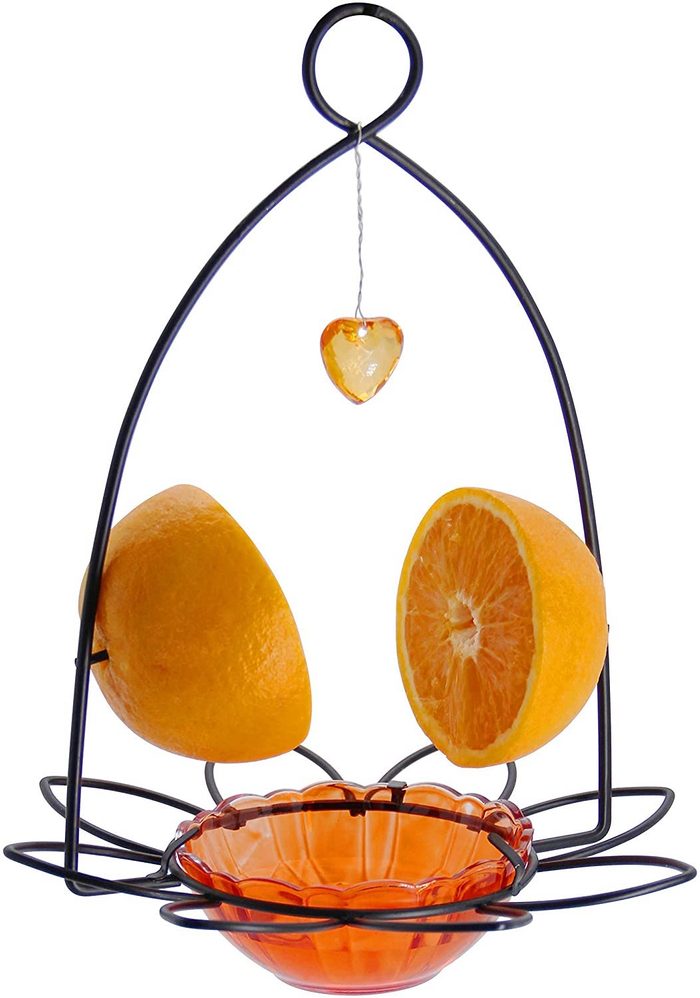
Flower Shaped Oriole Feeder
Attract fruit-loving birds two different ways with this oriole feeder. Pierce an orange half on one of the metal branches and add grape jelly to the glass bowl, which is included. It’s also a gorgeous piece of art to admire!
Learn how to attract orioles to your backyard.

Peanut Butter Feeder
Accommodate two hungry birds at once with this no mess peanut butter feeder. But first: Here’s what you should know about feeding birds peanut butter. We think you could also use this feeder to serve jelly or mealworms.
Don’t miss 10 unique bird feeders you can buy on Etsy.

Top-Fill Hummingbird Feeder
You won’t have to worry about spilling hummingbird sugar water with this top-fill feeder that’s designed to prevent leaks. The feeder is clear, so it’s easy to see when it needs cleaning. Plus, it’s got built-in bee guards to discourage unwanted swarming visitors.
Psst—we found more hummingbird feeders and accessories your birds will love.
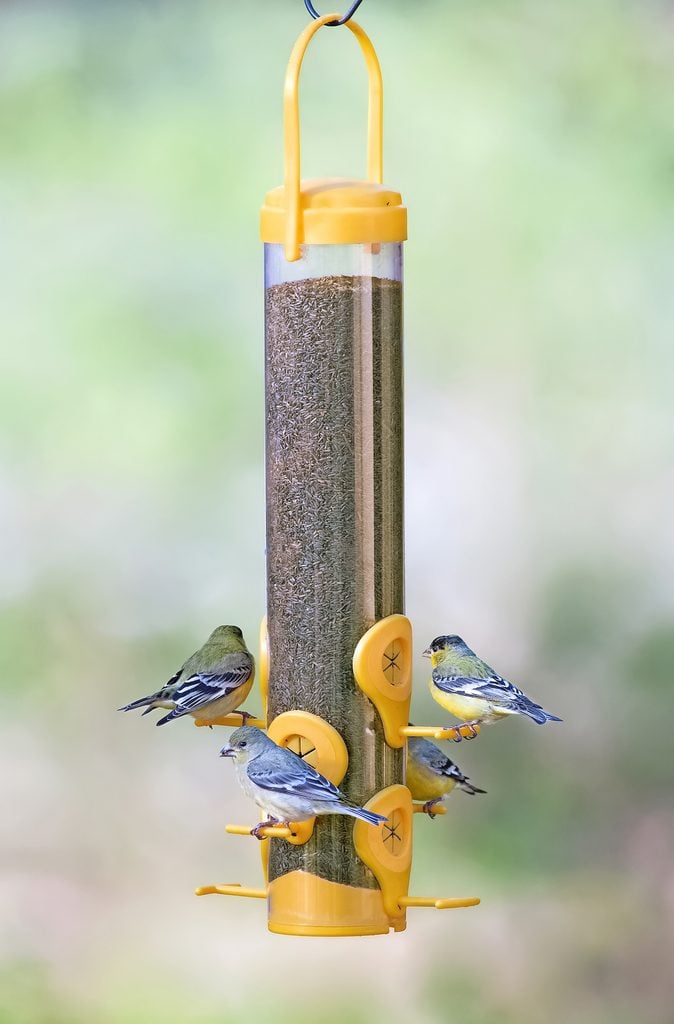
Perky-Pet Finch Feeder with Flexports
Attract sunny goldfinches other small songbirds such as pine siskins and common redpolls with a no mess finch feeder. Fill it with Nyjer thistle seed; the rubber Flexports prevent seed from leaking out all over your yard.

Squirrel Proof Double Suet Feeder
Serving suet is a less-messy option than seed feeders. Whether you prefer buying premade suet cakes or trying a homemade suet recipe, you won’t have to worry about furry visitors or bully birds stealing the food. This squirrel proof double suet feeder holds two suet cakes at once, and the cage is designed to let in smaller suet-loving birds, like downy woodpeckers and nuthatches.
Here’s how to get rid of blackbirds and grackles at feeders.
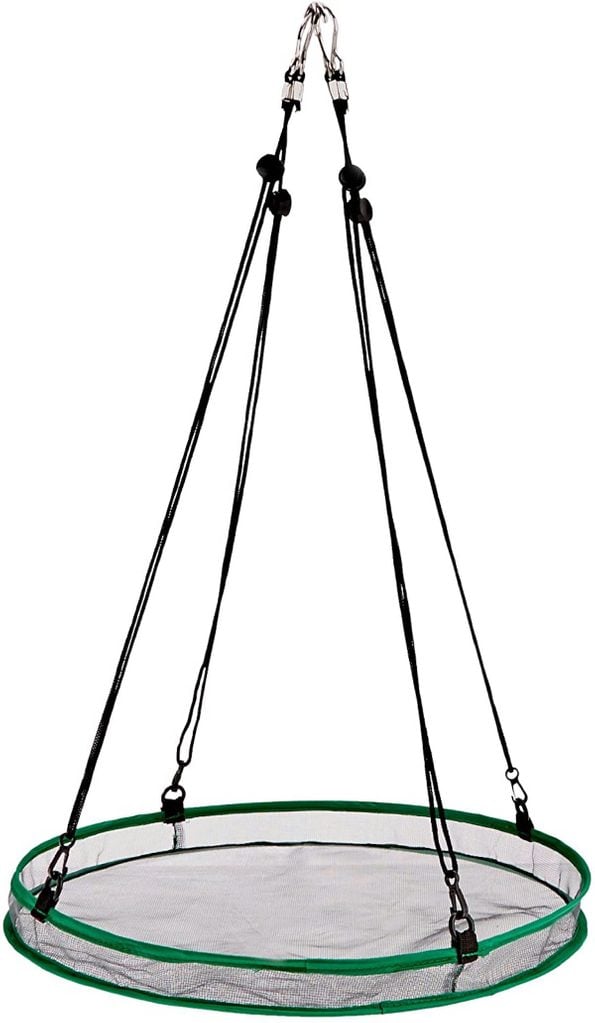
Hoop Bird Seed Catcher
Attach this hoop bird seed catcher below a messy bird feeder to grab all the shells that birds flick away. It’s 16 inches across, so it’ll keep a porch, balcony or other spot in your yard nice and clean. Ground feeding birds like sparrows and mourning doves may land on the hoop to clean up the leftovers.
Check out the best finch feeders to serve thistle seeds.

Brome Squirrel Buster Nut Feeder
Put shelled peanuts or suet nuggets into this Squirrel Buster nut feeder for minimal mess. The weight of squirrels will close the feeding ports, which means the birds will be able to happily feast.
Next, check out more of the best peanut bird feeders.
